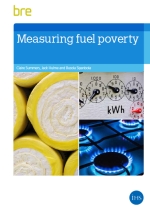Measuring fuel poverty
BRE is an independent, research-based consultancy, testing and training organisation, operating in the built environment and associated industries.
On 3 June 2016, BRE published Measuring Fuel Poverty, written by Claire Summers, Jack Hulme and Busola Siyanbola.
BRE has been measuring fuel poverty on behalf of the UK government since the 1990s. The new publication describes the origins and development of the fuel poverty concept, its measurement in the UK, and how it is used to help target those households most at risk of being unable to heat their homes.
The concept considers that households in fuel poverty may be placing themselves at risk by not heating their homes to sufficiently to prevent ill health. To assist these households, it is first necessary to identify them.
The two main measures of fuel poverty are the 10% definition and the Hills Low Income High costs (LIHC) definition.
- The 10% definition identifies fuel-poor households as those that would be required to spend more than 10% of their household income on fuel in order to meet a specified heating regime.
- The Hills LIHC definition identifies fuel-poor households as those with an income below the official poverty line coupled with higher-than-average fuel costs.
At present the Hills LIHC definition is used to measure fuel poverty in England, whilst the 10% definition is used in Scotland, Wales and Northern Ireland.
The publication explains the development and definitions of fuel poverty, and summarises fuel poverty trends over time. It considers who the fuel poor are, and looks at the reasons for changing levels of fuel poverty. It is intended to provide background to the concept for housing associations and housing providers, energy suppliers, policy makers, energy consultants and academics.
Its contents are:
- Introduction
- Fuel poverty methodology
- Fuel poverty trends
- Fuel poverty at a local level
- Conclusions and the future of fuel poverty development
- References
[edit] Related articles on Designing Buildings
- A measure of net well-being that incorporates the effect of housing environmental impacts.
- Adapting 1965-1980 semi-detached dwellings in the UK to reduce summer overheating and the effect of the 2010 Building Regulations.
- Anatomy of low carbon retrofits: evidence from owner-occupied superhomes.
- BRE and Willmott Dixon project to retrofit of a 1920s semi-detached house.
- Building Research Establishment BRE
- Energy companies obligation ECO.
- Fuel poverty.
- Green deal scrapped.
- Heat Energy: The Nation’s Forgotten Crisis.
- Housing contribution to regeneration.
- Poverty.
- Renovation Wave Strategy RWS.
- The cold man of europe 2015.
- The full cost of poor housing.
- The Future of Electricity in Domestic Buildings.
- The real cost of poor housing.
- Transitioning to eco-cities: Reducing carbon emissions while improving urban welfare.
- Well-being and regeneration: Reflections from Carpenters Estate.
- Wellbeing.
Featured articles and news
Latest Build UK Building Safety Regime explainer published
Key elements in one short, now updated document.
UKGBC launch the UK Climate Resilience Roadmap
First guidance of its kind on direct climate impacts for the built environment and how it can adapt.
CLC Health, Safety and Wellbeing Strategy 2025
Launched by the Minister for Industry to look at fatalities on site, improving mental health and other issues.
One of the most impressive Victorian architects. Book review.
Common Assessment Standard now with building safety
New CAS update now includes mandatory building safety questions.
RTPI leader to become new CIOB Chief Executive Officer
Dr Victoria Hills MRTPI, FICE to take over after Caroline Gumble’s departure.
Social and affordable housing, a long term plan for delivery
The “Delivering a Decade of Renewal for Social and Affordable Housing” strategy sets out future path.
A change to adoptive architecture
Effects of global weather warming on architectural detailing, material choice and human interaction.
The proposed publicly owned and backed subsidiary of Homes England, to facilitate new homes.
How big is the problem and what can we do to mitigate the effects?
Overheating guidance and tools for building designers
A number of cool guides to help with the heat.
The UK's Modern Industrial Strategy: A 10 year plan
Previous consultation criticism, current key elements and general support with some persisting reservations.
Building Safety Regulator reforms
New roles, new staff and a new fast track service pave the way for a single construction regulator.
Architectural Technologist CPDs and Communications
CIAT CPD… and how you can do it!
Cooling centres and cool spaces
Managing extreme heat in cities by directing the public to places for heat stress relief and water sources.
Winter gardens: A brief history and warm variations
Extending the season with glass in different forms and terms.
Restoring Great Yarmouth's Winter Gardens
Transforming one of the least sustainable constructions imaginable.
























